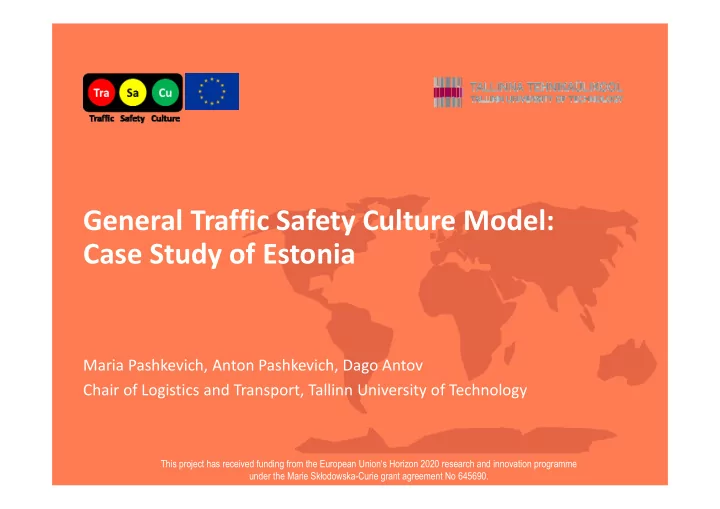

General Traffic Safety Culture Model: Case Study of Estonia Maria Pashkevich, Anton Pashkevich, Dago Antov Chair of Logistics and Transport, Tallinn University of Technology This project has received funding from the European Union‘s Horizon 2020 research and innovation programme under the Marie Sk ł odowska-Curie grant agreement No 645690.
Theoretical Model • Why the current approach is not enough? Why do we need a safety culture model? • Traffic safety work split to different bodies
Risk Homeostasis Theory (RHT)
Goal of transportation
Goal of transportation
What is safety culture? • For a transportation organization (e.g., company, public transport agent): • The shared beliefs and values of members of working in an organization that determine the commitment to and quality of an organization's health and safety management • For traffic system: • A social climate in which traffic safety is highly valued and rigorously pursued • TraSaCu: • Traffic safety culture is defined as the shared values, actions, and behaviours that demonstrate a commitment to safety over competing goals and demands. (US Department of Transportation Safety Council)
Traffic (safety) culture as a new paradigm • Parker (2007) described the three eras of safety as an expansion of perspectives on accident phenomena by emphasizing their supplementary characteristics.
Levels of maturity with respect to a safety culture
Traffic culture means interaction between individuals and social systems
General Traffic Safety Culture Model • Vertical levels: 1. Micro: individual road user 2. Meso: organization/group 3. Macro: county/region/country 4. Magna: overall culture
General Traffic Safety Culture Model • Horizontal dimensions: 1. Origins: distal factors 2. Cultural components (e.g. values, norms) 3. Proximal factors (practices, artifacts) 4. Outcomes/consequences
General Traffic Safety Culture Model • Model includes also: 1. Outside influences 2. Main goals and aims 3. Interdependency and feedback between levels and dimensions
General Traffic Safety Culture Model
General Traffic Safety Culture Model Exposure—that is, the degree to which a driver exposes him- or herself to traffic and thus the probability of being involved in an accident—is “a systematic process affecting the crash system” (Chapman, 1973)
What is the benefit of the holistic safety culture model? • Describes the complexity of cultural processes in one holistic model • Takes the interdependency of different levels into account • Makes clear the cultural mechanisms so that interventions can be targeted according to level and dimension o Method of intervention should be chosen according to the target level • Works not only for prevention, but also promotion
TraSaCu Project • http://www.trasacu.eu/
TraSaCu Project Traffic Safety Culture in Practice Analysis of Cultural Patterns in (Road) Commitment and Compliance Traffic Systems Synthesis Development of Action Framework
TraSaCu Project – Methodology • Country Reports • Expert Interviews • Fieldwork Diary • Observations • Internet Surveys • Available secondary data
TraSaCu Project – Methodology – Expert Interviews • Experts in • policy making • safety engineering • accident analysis • accident prevention • road policing
TraSaCu Project – Methodology – Fieldwork Diary • Adapting to the new situation • Becoming aware of difference: What makes the difference • Integration in the flow of work between the culture in which of the hosting organization you are socialized as • Encounters with experts compared to the culture you • Personal experiences with are facing now? traffic situations • Some hypotheses about the • Feelings andemotions underlying pattern of your observations. • The researcherspersonal view.
TraSaCu Project – Methodology – Observations • Aim: to provide behavioral data • Topics: for country descriptions and 1. Seat belt wearing comparisons 2. Bicycle helmet use 3. Child sear use • Assumption: even rough 4. Indicator use measurements reflect that 5. Motorcycle helmet use aspect of safe behaviors in a 6. Non-signalized crossing country 7. Signalized crossing • Method: measurements in roughly similar sites and times
TraSaCu Project – Methodology – Survey • Contents: • Background Exposure, accidents, demographics… • • Transport mode choice • Road user behaviors (with modified DBQ) Driver, cyclist, motorcyclist • • Traffic Climate Scale • Portrait Value Questionnaire (Schwartz values) • Driver Aggression – self vs. other
Thank you! Contact details: Dr. Anton Pashkevich Tallinn University of Technology Faculty of Mechanical Engineering Department of Mechanical and Industrial Engineering Chair of Logistics and Transport Phone: +372 55 29 162 Email: anton.pashkevich@ttu.ee www.ttu.ee/logistika This project has received funding from the European Union‘s Horizon 2020 research and innovation programme under the Marie Sk ł odowska-Curie grant agreement No 645690.
Recommend
More recommend